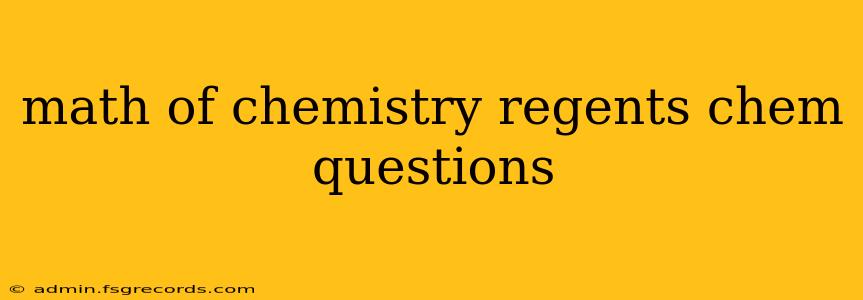The New York State Regents Chemistry exam can be daunting, but a significant portion of the challenge lies in the mathematical calculations required. This guide breaks down the essential math concepts and provides strategies for tackling these questions confidently. Mastering these skills is crucial for achieving a high score.
Key Math Concepts in Regents Chemistry
Several mathematical concepts underpin the chemistry Regents exam. Understanding and practicing these will significantly improve your performance.
1. Dimensional Analysis (Unit Conversions):
This is arguably the most important math skill for the Regents. Dimensional analysis involves converting units using conversion factors. For example, converting grams to moles, liters to milliliters, or Celsius to Kelvin. Practice problems focusing on these conversions is essential.
Example: Convert 25 grams of water (H₂O) to moles. (Molar mass of H₂O ≈ 18 g/mol)
Solution: 25 g H₂O * (1 mol H₂O / 18 g H₂O) = 1.39 moles H₂O
2. Stoichiometry Calculations:
Stoichiometry involves using balanced chemical equations to determine the quantitative relationships between reactants and products. This includes mole-to-mole conversions, mole-to-gram conversions, and gram-to-gram conversions.
Example: Given the balanced equation: 2H₂ + O₂ → 2H₂O, how many moles of water are produced from 4 moles of hydrogen gas?
Solution: Using the mole ratio from the balanced equation: 4 moles H₂ * (2 moles H₂O / 2 moles H₂) = 4 moles H₂O
3. Molarity and Solution Calculations:
Understanding molarity (moles of solute per liter of solution) is crucial. You'll need to calculate molarity, moles of solute, or volume of solution. Dilution problems (M₁V₁ = M₂V₂) are also frequently tested.
Example: What is the molarity of a solution containing 0.5 moles of NaCl in 2 liters of solution?
Solution: Molarity = moles of solute / liters of solution = 0.5 moles / 2 L = 0.25 M
4. Gas Laws:
The ideal gas law (PV = nRT) and other gas laws (Boyle's, Charles's, Gay-Lussac's) require manipulating equations and solving for unknowns. Make sure you understand the units involved (pressure in atm, volume in L, temperature in Kelvin, etc.).
5. Percent Composition and Empirical Formulas:
Calculating the percent composition of a compound and determining empirical and molecular formulas often involves using molar mass and ratios.
Example: What is the percent composition of oxygen in H₂O? (Molar mass of H₂O ≈ 18 g/mol; molar mass of O ≈ 16 g/mol)
Solution: (16 g/mol O / 18 g/mol H₂O) * 100% ≈ 89%
6. Basic Algebra and Solving Equations:
Regents chemistry questions frequently require solving algebraic equations for an unknown variable. This involves rearranging formulas and performing basic arithmetic operations.
Strategies for Success
- Practice, Practice, Practice: The key to mastering the math in Regents chemistry is consistent practice. Work through numerous problems from past exams and review materials.
- Understand the Concepts: Don't just memorize formulas; understand the underlying concepts. This will help you approach unfamiliar problems with confidence.
- Identify Your Weaknesses: Focus on the areas where you struggle the most. Seek help from teachers, tutors, or online resources.
- Use Units to Check Your Work: Always include units in your calculations. This will help you catch mistakes and ensure your answer is in the correct units.
- Organize Your Work: Show your work clearly and neatly. This will make it easier to identify errors and earn partial credit if you make a mistake.
By focusing on these key math concepts, practicing diligently, and employing effective strategies, you can significantly improve your performance on the math-related questions of the New York State Regents Chemistry exam. Remember, consistent effort and a clear understanding of the underlying principles are the keys to success.

